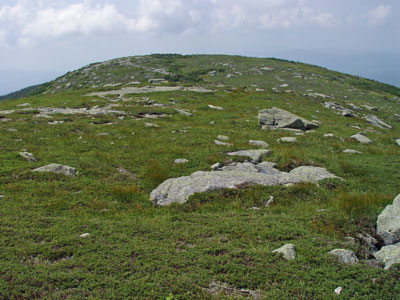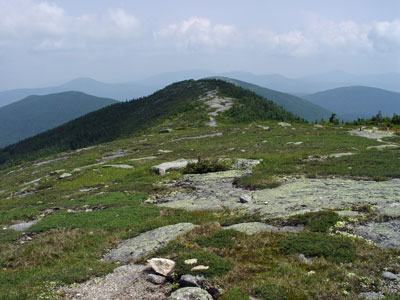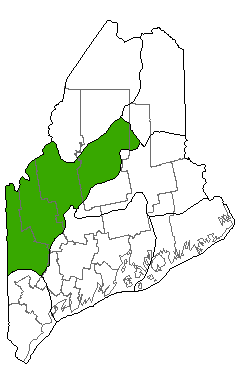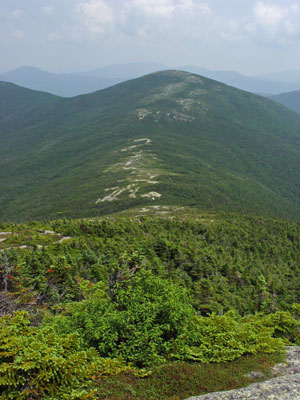DACF Home → Bureaus & Programs → Maine Natural Areas Program → Communities, Plants, and Animals → Natural Community Fact Sheets → Windswept Alpine Ridge
Printer Friendly Fact Sheet - 1.1 MB pdf Get a free copy of Adobe Acrobat Reader)
Windswept Alpine Ridge
Scientific Name: Diapensia Alpine Ridge; State Rank: S1

- Community Description
- Soil and Site Characteristics
- Diagnostics
- Similar Types
- Conservation, Wildlife and Management Considerations
- Distribution
- Characteristic Plants
- Associated Rare Plants
- Associated Rare Animals
- Examples on Conservation Lands You Can Visit
Community Description: Matted evergreen shrubs and a few herbs are scattered among boulders or in bedrock pockets in an open alpine setting. Cushions of diapensia are the dominant feature, and alpine bilberry is typically common as well. The cover of herb species is usually <20%, and graminoids such as Bigelow’s sedge and highland rush are typically more abundant than forbs. Older mats of diapensia may exhibit dieback. Back to top.
Soil and Site Characteristics: Sites occur on very exposed and windswept areas above treeline, with plants growing in gravelly substrate among fractured rocks. Slopes are flat to gentle. Back to top.

Diagnostics: Diapensia is the dominant species with >20% cover. Back to top.
Similar Types: Heath Alpine Ridge can occur at similar elevations and can grade into this type, but diapensia, if present, is sparse (< 20% cover). Alpine Snowbanks similarly lack extensive diapensia. Rocky Summit Heath and Mid-elevation Balds lack diapensia and other strictly alpine species and generally occur at lower elevations. Back to top.
Conservation, Wildlife and Management Considerations: This type is restricted even within the alpine zone and is very sensitive to hiker impacts. Because the vegetation is characteristically sparse and often occurs on flats, it is easy for hikers to wander off trail. The documented Maine sites occur on public lands or private conservation lands, where hiker impacts are the main management concern.
Mt. Katahdin is the only known nesting area in the state for the American pipit, which uses a variety of natural community types above treeline. Back to top.
Distribution: Restricted to Maine's highest mountains (New England - Adirondack Province), extending west to New Hampshire and along the Appalachians, and possibly northeastward to the Gaspé peninsula. Landscape Pattern: Small Patch. Back to top.


Characteristic Plants: These plants are frequently found in this community type. Those with an asterisk are often diagnostic of this community.
- Dwarf Shrub
- Alpine azalea
- Alpine bearberry
- Alpine bilberry*
- Black crowberry
- Diapensia*
- Herb
- Bigelow's sedge
- Boreal bentgrass
- Highland rush
- Mountain sandwort
- Northern firmoss
- Three-toothed cinquefoil
- Bryoid
- Cetraria lichen
- Alpine bearberry
- Alpine sweet-grass
- Bearberry willow
- Bigelow's sedge
- Boreal bentgrass
- Cutler's goldenrod
- Lapland diapensia
- Lapland rosebay
- Mountain sandwort
- Northern firmoss
- American pipit
Examples on Conservation Lands You Can Visit
| Example | County |
|---|---|
| Mt. Abraham | Franklin Co. |
| Mt. Katahdin, Baxter State Park | Piscataquis Co. |
| Saddleback Mountain, Appalachian Trail | Franklin Co. |
